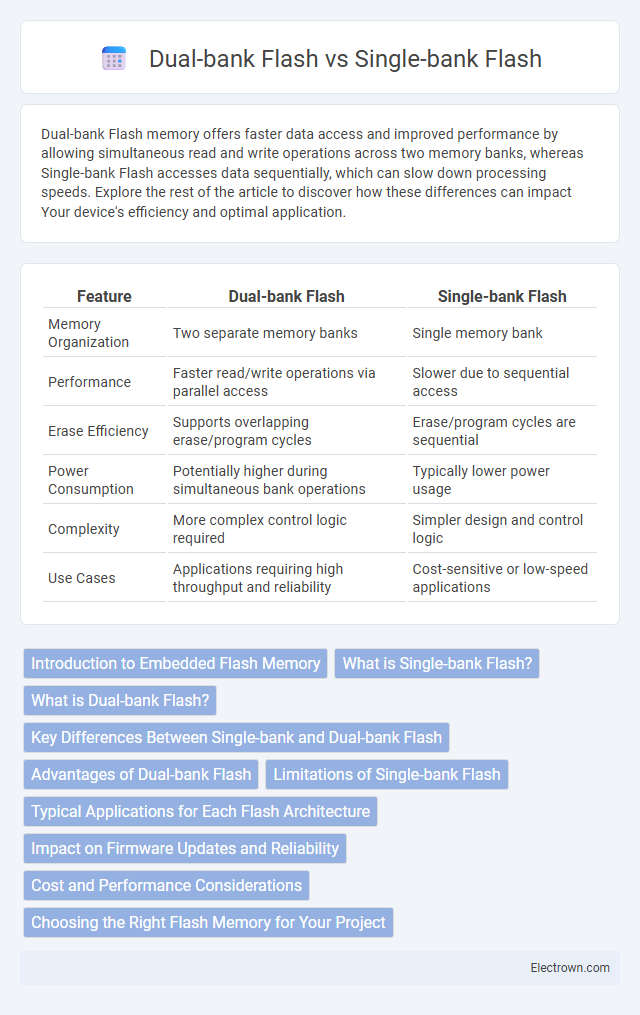Dual-bank Flash memory offers faster data access and improved performance by allowing simultaneous read and write operations across two memory banks, whereas Single-bank Flash accesses data sequentially, which can slow down processing speeds. Explore the rest of the article to discover how these differences can impact Your device's efficiency and optimal application.
Table of Comparison
| Feature | Dual-bank Flash | Single-bank Flash |
|---|---|---|
| Memory Organization | Two separate memory banks | Single memory bank |
| Performance | Faster read/write operations via parallel access | Slower due to sequential access |
| Erase Efficiency | Supports overlapping erase/program cycles | Erase/program cycles are sequential |
| Power Consumption | Potentially higher during simultaneous bank operations | Typically lower power usage |
| Complexity | More complex control logic required | Simpler design and control logic |
| Use Cases | Applications requiring high throughput and reliability | Cost-sensitive or low-speed applications |
Introduction to Embedded Flash Memory
Embedded Flash Memory serves as a critical non-volatile storage component in microcontrollers, where Single-bank Flash offers straightforward memory access but limits system performance due to sequential read/write operations. Dual-bank Flash enhances efficiency by allowing simultaneous read and write cycles, significantly improving execution speed and system responsiveness in embedded applications. You can optimize your device's performance by selecting Dual-bank Flash when rapid code execution and reduced latency are essential.
What is Single-bank Flash?
Single-bank Flash is a memory architecture where all the flash memory cells are organized into a single contiguous block accessible by the controller. This design allows sequential access to the entire flash memory space but limits parallelism in read/write operations. Single-bank Flash typically results in simpler controller design but may exhibit slower performance compared to dual-bank configurations due to the lack of simultaneous multi-bank operations.
What is Dual-bank Flash?
Dual-bank Flash is a memory architecture that divides the Flash memory into two separate banks, allowing simultaneous read and write operations. This design significantly improves system performance by enabling faster data access and reducing latency compared to Single-bank Flash, where memory operations occur sequentially. Your device benefits from increased efficiency and enhanced multitasking capabilities when utilizing Dual-bank Flash technology.
Key Differences Between Single-bank and Dual-bank Flash
Single-bank Flash stores data in one continuous memory bank, which limits simultaneous read/write operations, while Dual-bank Flash divides memory into two banks, enabling concurrent access and improving performance. Dual-bank Flash offers enhanced reliability through error correction by isolating faults in one bank without affecting the other. Understanding these key differences helps you optimize memory management and system efficiency based on your application's speed and redundancy requirements.
Advantages of Dual-bank Flash
Dual-bank Flash memory offers significant advantages over Single-bank Flash by enabling simultaneous read and write operations, which enhances overall system performance and reduces latency. This configuration increases data throughput and allows for more efficient multitasking, making it ideal for applications requiring fast and reliable memory access. Your devices benefit from improved speed and responsiveness, supporting advanced computing needs and extending operational lifespan.
Limitations of Single-bank Flash
Single-bank Flash memory is limited by its inability to perform simultaneous read and write operations, which slows down overall system performance. This single-channel structure restricts data throughput and increases latency during flash memory access. Your applications may experience bottlenecks if they require high-speed data processing or parallel memory access, making dual-bank Flash a more efficient alternative for enhanced multitasking and responsiveness.
Typical Applications for Each Flash Architecture
Dual-bank Flash is typically used in safety-critical and automotive applications where fast firmware updates and redundancy are essential, such as engine control units (ECUs) and advanced driver-assistance systems (ADAS). Single-bank Flash suits simpler consumer electronics and IoT devices that prioritize cost-effectiveness and lower complexity without the need for simultaneous read/write operations. The choice between these architectures often depends on system reliability requirements and firmware update speed demands.
Impact on Firmware Updates and Reliability
Dual-bank Flash technology enhances firmware updates by enabling background programming on one bank while the system runs from the other, significantly reducing downtime and improving update efficiency. This approach increases reliability by allowing fail-safe firmware recovery in case of update interruptions, as your device can revert to the stable code stored in the alternate bank. Single-bank Flash, in contrast, requires the entire memory to be unavailable during updates, raising the risk of bricking and longer system unavailability.
Cost and Performance Considerations
Dual-bank Flash memory typically offers better performance than Single-bank Flash by enabling simultaneous read and write operations, reducing latency and improving data throughput. However, Dual-bank Flash often incurs higher costs due to increased complexity and manufacturing expenses, which can impact your overall budget. Choosing between these options depends on balancing your performance requirements against cost constraints.
Choosing the Right Flash Memory for Your Project
Selecting between Dual-bank Flash and Single-bank Flash hinges on your project's speed and reliability requirements. Dual-bank Flash offers simultaneous read/write operations, effectively reducing latency and boosting performance, ideal for complex applications needing multitasking capabilities. Your decision should weigh the need for faster access and uninterrupted operation against budget and power consumption constraints.
Dual-bank Flash vs Single-bank Flash Infographic

 electrown.com
electrown.com